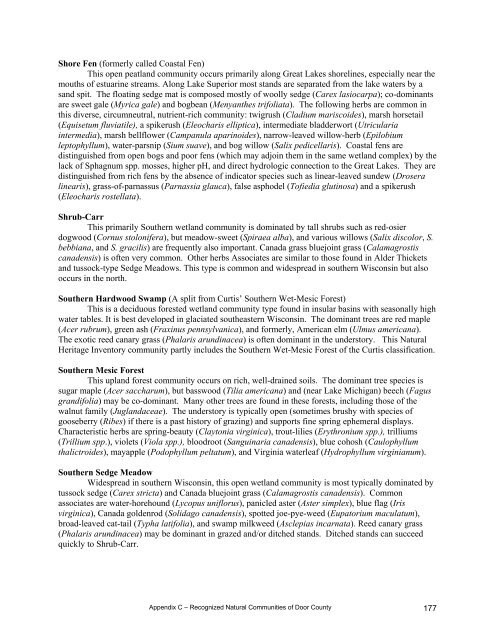Guide to Significant Wildlife Habitat - Door County Web Map
Guide to Significant Wildlife Habitat - Door County Web Map
Guide to Significant Wildlife Habitat - Door County Web Map
You also want an ePaper? Increase the reach of your titles
YUMPU automatically turns print PDFs into web optimized ePapers that Google loves.
Shore Fen (formerly called Coastal Fen)<br />
This open peatland community occurs primarily along Great Lakes shorelines, especially near the<br />
mouths of estuarine streams. Along Lake Superior most stands are separated from the lake waters by a<br />
sand spit. The floating sedge mat is composed mostly of woolly sedge (Carex lasiocarpa); co-dominants<br />
are sweet gale (Myrica gale) and bogbean (Menyanthes trifoliata). The following herbs are common in<br />
this diverse, circumneutral, nutrient-rich community: twigrush (Cladium mariscoides), marsh horsetail<br />
(Equisetum fluviatile), a spikerush (Eleocharis elliptica), intermediate bladderwort (Utricularia<br />
intermedia), marsh bellflower (Campanula aparinoides), narrow-leaved willow-herb (Epilobium<br />
lep<strong>to</strong>phyllum), water-parsnip (Sium suave), and bog willow (Salix pedicellaris). Coastal fens are<br />
distinguished from open bogs and poor fens (which may adjoin them in the same wetland complex) by the<br />
lack of Sphagnum spp. mosses, higher pH, and direct hydrologic connection <strong>to</strong> the Great Lakes. They are<br />
distinguished from rich fens by the absence of indica<strong>to</strong>r species such as linear-leaved sundew (Drosera<br />
linearis), grass-of-parnassus (Parnassia glauca), false asphodel (Tofiedia glutinosa) and a spikerush<br />
(Eleocharis rostellata).<br />
Shrub-Carr<br />
This primarily Southern wetland community is dominated by tall shrubs such as red-osier<br />
dogwood (Cornus s<strong>to</strong>lonifera), but meadow-sweet (Spiraea alba), and various willows (Salix discolor, S.<br />
bebbiana, and S. gracilis) are frequently also important. Canada grass bluejoint grass (Calamagrostis<br />
canadensis) is often very common. Other herbs Associates are similar <strong>to</strong> those found in Alder Thickets<br />
and tussock-type Sedge Meadows. This type is common and widespread in southern Wisconsin but also<br />
occurs in the north.<br />
Southern Hardwood Swamp (A split from Curtis’ Southern Wet-Mesic Forest)<br />
This is a deciduous forested wetland community type found in insular basins with seasonally high<br />
water tables. It is best developed in glaciated southeastern Wisconsin. The dominant trees are red maple<br />
(Acer rubrum), green ash (Fraxinus pennsylvanica), and formerly, American elm (Ulmus americana).<br />
The exotic reed canary grass (Phalaris arundinacea) is often dominant in the unders<strong>to</strong>ry. This Natural<br />
Heritage Inven<strong>to</strong>ry community partly includes the Southern Wet-Mesic Forest of the Curtis classification.<br />
Southern Mesic Forest<br />
This upland forest community occurs on rich, well-drained soils. The dominant tree species is<br />
sugar maple (Acer saccharum), but basswood (Tilia americana) and (near Lake Michigan) beech (Fagus<br />
grandifolia) may be co-dominant. Many other trees are found in these forests, including those of the<br />
walnut family (Juglandaceae). The unders<strong>to</strong>ry is typically open (sometimes brushy with species of<br />
gooseberry (Ribes) if there is a past his<strong>to</strong>ry of grazing) and supports fine spring ephemeral displays.<br />
Characteristic herbs are spring-beauty (Clay<strong>to</strong>nia virginica), trout-lilies (Erythronium spp.), trilliums<br />
(Trillium spp.), violets (Viola spp.), bloodroot (Sanguinaria canadensis), blue cohosh (Caulophyllum<br />
thalictroides), mayapple (Podophyllum peltatum), and Virginia waterleaf (Hydrophyllum virginianum).<br />
Southern Sedge Meadow<br />
Widespread in southern Wisconsin, this open wetland community is most typically dominated by<br />
tussock sedge (Carex stricta) and Canada bluejoint grass (Calamagrostis canadensis). Common<br />
associates are water-horehound (Lycopus uniflorus), panicled aster (Aster simplex), blue flag (Iris<br />
virginica), Canada goldenrod (Solidago canadensis), spotted joe-pye-weed (Eupa<strong>to</strong>rium maculatum),<br />
broad-leaved cat-tail (Typha latifolia), and swamp milkweed (Asclepias incarnata). Reed canary grass<br />
(Phalaris arundinacea) may be dominant in grazed and/or ditched stands. Ditched stands can succeed<br />
quickly <strong>to</strong> Shrub-Carr.<br />
Appendix C – Recognized Natural Communities of <strong>Door</strong> <strong>County</strong> 177




![A Guide to the Control and Management of Invasive Phragmites [PDF]](https://img.yumpu.com/19126786/1/190x190/a-guide-to-the-control-and-management-of-invasive-phragmites-pdf.jpg?quality=85)







![Homeowner's Guide to Japanese Knotweed Control [PDF]](https://img.yumpu.com/19126766/1/190x245/homeowners-guide-to-japanese-knotweed-control-pdf.jpg?quality=85)




